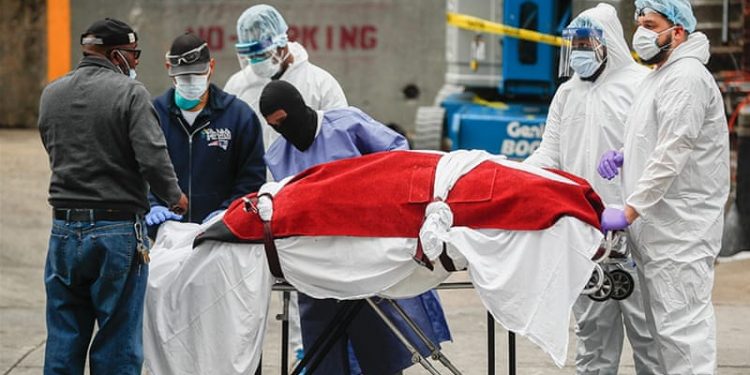Washington: The confirmed coronavirus death toll in the United States reached 32,917 Thursday, according to a tally by Johns Hopkins University.
The toll as of 8.30pm (US time) marked an increase of 4,491 deaths in the past 24 hours, by far the highest daily toll in the pandemic so far. But the figure likely includes ‘probable’ deaths related to COVID-19, which were not previously included.
As of Thursday night, the US Centers for Disease Control and Prevention had recorded 31,071 coronavirus deaths, including 4,141 ‘probable’ virus deaths.
The US has the highest death toll in the world, followed by Italy with 22,170 dead although its population is just a fifth of that of America. Spain has recorded 19,130 deaths, followed by France with 17,920.
More than 6,67,800 coronavirus cases have been recorded in the US, which has seen a record number of deaths over the past two days. New York, the epicenter of the country’s COVID-19 epidemic, has suffered more than 12,000 deaths across the state alone.
Meanwhile, President Donald Trump unveiled plans Thursday evening to reopen the US economy, allowing each state’s governor ‘to take a phased deliberate approach to reopening their individual states’.
Currently more than 95 per cent of America’s 330 million population is under a stay-at-home order and over 22 million Americans have applied for unemployment benefits.
Asserting that a prolonged lockdown, combined with a forced economic depression, would inflict an immense and wide-ranging toll on public health, Donald Trump told reporters Thursday that his administration is issuing new federal guidelines that will allow governors to take a phased approach to reopening their individual states.
Trump said healthy Americans will now be able to return to work if conditions on the ground allow.
“Instead of a blanket shutdown, we will pursue a focus on sheltering the highest risk individuals,” Trump said. He added that his administration is establishing clear scientific metric and benchmarks on testing new case growth and hospital capacity that must be met before advancing to each phase.
“If the virus returns in the fall, as some scientists think it may, possibly, these guidelines will ensure that our country is up and running so that we can likewise put it out quickly,” he said.
The guidelines were developed by top medical experts from across the government. The guidelines empower governors to tailor the phased reopening to address the situation in their states.
The guidelines criteria set clear benchmarks on new cases, testing, and hospital resources for states to meet before proceeding toward a phased reopening.
For the first phase, the guidelines recommends that states see a downward trajectory for 14 days in the number of confirmed coronavirus cases as well as flu-like symptoms before they move to lift stay-at-home orders and other restrictions meant to curb the spread of the virus.
AFP






































